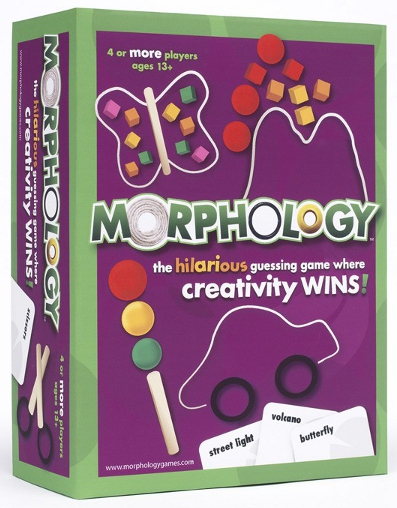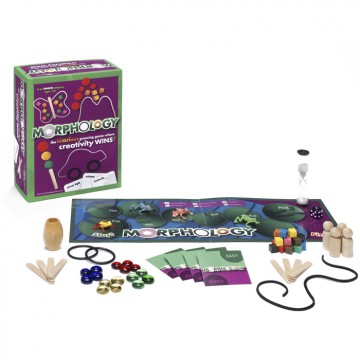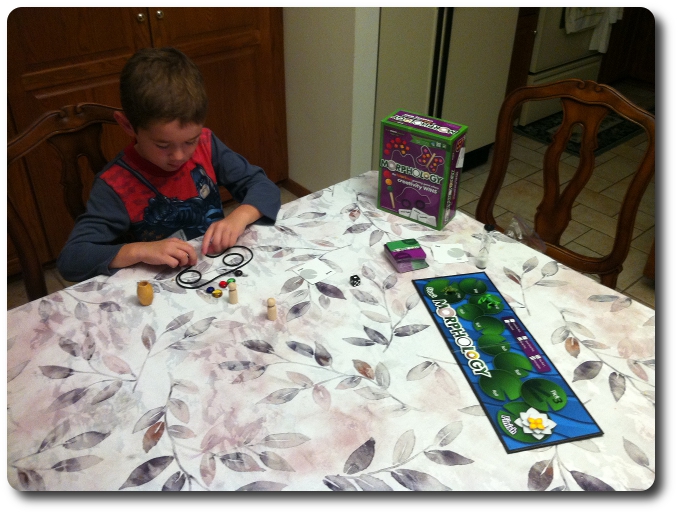
The Basics:
- For ages 4 and up (publisher suggests 13+)
- For 4 or more players (but you play as teams, preferably with equal number of players per team)
- About 30 minutes to complete
Geek Skills:
- Active Listening & Communication
- Logical & Critical Decision Making
- Visuospatial Skills
- Reading
- Cooperative & Team Play
- Imagination
- Reflex & Speed
Learning Curve:
- Child – Easy
- Adult – Easy
Theme & Narrative:
- None
Endorsements:
- Gamer Geek rejected!
- Parent Geek approved!
- Child Geek approved!
Overview
In Morphology, teams must work together to guess what an object or idea is via creative representation through bits of string, beads, wooden pawns, and other small pieces. The trick is recreating the “thing” fast enough using the pieces provided in a manner that your team can guess correctly. While this might seem like an easy exercise, there is a strictly imposed time limit and subtle game changers that make how the Morphologist (the person who is recreating the selected word) goes about it. Fast, fun, and creative, this is a great game for parties and family game days.
Morphology is comprised of many parts. First, there is a game board that keeps track of the different teams’ progress towards winning the game. Second, there is a huge stack of cards with easy and hard words that is used to randomly select what word the Morphologist must recreate. Third, there are small frogs that are used to represent each team on the game board (which makes total sense, since each step towards victory is a lily pad), Fourth, a standard six-sided dice which is used to randomly determine different rules of play during the game and a 60-second sand timer. Fifth, and certainly not at all least, are the many bits and pieces that are used to recreate words. Wooden pawns, a bit of string, round rubber washers, glass beads, small Popsicle sticks, small wooden blocks of different colors, and a large wooden piece with a hole through the middle. Phew! That’s a lot of pieces and everything included in the game is of high quality and durable. Good thing, too, as these pieces will be used in abundance throughout the game.

There’s a lot in the box and all of it will be used!
Game Set up
First, put the teams together. It is preferable to have at least 2 people per team, but having fewer teams will make the game go faster and the guessing more enjoyable. To set up the game, remove the game board and put one frog on the starting position for each team. The deck of word cards should be shuffled and placed face-down to one side within easy reach of the players. Decide before play which words will be used, easy or hard.
Lastly, place all the game pieces that are used to recreate the words in the middle of the table. It should be noted that Morphology will require enough game play space to allow for the Morphologist to recreate the word without the burden of lack of space to do so. Your typical family gaming table should be suffice, but a small coffee table will simply not work.
You are now ready to play!
Morphologing (or, How to Play)
On the team’s turn, they choose one of their team members to be the Morphologist. This person will draw one of the word cards and read it to themself. Once they read it, one of the other teams will start the sand timer. The Morphologist now has 60-seconds to use the game pieces to recreate the word. The Morphologist cannot openly discuss what they are trying to recreate, verbally answer any questions from their teammates, spell out words, or use themselves as part of the word creation (i.e. “the Morphologist is not a game piece). However, the Morphologist is permitted to nod or shake their head, grunt approval or disapproval, and roll their eyes at their fellow team members.
This is the general way in which the Morphologist and his or her team go about guessing the word on their turn; however, the game does change slightly based on the team’s space on the game board. In total, there are 3 different types of spaces. The one described above is considered “Play”, which has no other rules than the standard ones provided. The two others are “Roll” and “Pick 3”.
When on the “Roll” space, the team rolls the six-sided die which determines the rules of play for that round only. The possible outcomes include:
- Everybody Plays, wherein all teams play this round and each team’s Morphologists take turns selecting one game piece each until they all have 5 pieces in total. Then, all the Morphologist look at the same word card and play at once.
- Eyes Closed, wherein the Morphologist recreates the word with their eyes, yes you guessed it, closed.
- Weak Hand Only, wherein the Morphologist only uses their non-dominant hand.
- String Only, wherein the Morphologist can only use the string to recreate the word.
- You Pick 5, wherein the Morphologist selects five game pieces and then draws a word card.
- Interception, wherein the other teams are given an opportunity to guess the word if the active team does not.
When on the “Pick 3” space, the opposing teams select 3 unique game pieces to be used to recreate the word. After the pieces are selected, the Morphologist draws a word card. If the team fails to guess the word, on their next turn, 4 unique pieces are selected. If they continue to fail to guess the word, a unique piece is added each round, increasing the total number, until no more unique pieces can be added. Unique, in this case, means that only one game piece of each type can ever be selected. For example, you could not have 2 glass beads, even if they were different colors.
When a team correctly guesses the word within the given time limit, their frog advances one space towards the goal. Otherwise, their game piece stays put. The winner of the game is the first team who jumps their way to the last position on the game board!
Prediction
My little geeks love to create things. LEGO continues to be the medium of choice and also, on a side note, the single most painful thing in my house. I cannot even begin to tell you how many times I have stepped on those blasted things. I swear, they are like little caltrops! I’ll be walking, minding my own business, and – BANG! – shooting pain up my leg as I put my full weight down on a haphazardly discarded and forgotten LEGO brick.
But hold on, this article is about games…
As I was saying before my mind was flooded with painful memories, my little geeks love to be creative. They are always making up games, building something, or drawing. We encourage this in our household by displaying their artwork on the family fridge, putting art supplies low on shelves making them easily accessible, and dragging them (kicking and screaming) to art museums. It all started with picture books when our little geeks were just born and it continues to this day with coloring books, comics, and wordier literature. I doubt I’m raising the next Raphael or Thomas Hart Benton, but that really isn’t the point. A well-rounded geek is a happy geek.
We have found other cooperative games that involved “making things” for team members to guess to be a bit too complex for our little geeks. Not in the execution of the how to guess, but the “thing” itself. Complex ideas or objects that our little geeks have no real clue about make creating such things for others to guess an exercise in futility and frustration. We have had great success plaing Charades, especially Reverse Charades, which I have recently been told has released some cards specifically designed for little geeks.
Morphology has some very easy words for the little geeks to recreate using the many bits and pieces the game provides. This gives me great hope that my little geeks will be able to participate as equals at the table and feel like they really are contributing to the team, both as a Morphologist and as a guesser.
As already explained above in the overview, Morphology is a very straightforward game. Explaining the rules was not a problem and my little geeks understood what was expected of them. Most of their questions involved how they could use the game pieces. Could they stack them? Could they throw them? Could they choose to use only one? These were excellent questions as they demonstrated that my little geek’s already understood the basics and were now looking to define the game’s limitations.
So, after explaining the game, showing them several examples of how they could build things, and answering various questions, I got the game ready. As I was organizing all the pieces and the game board, I asked them their thoughts.
“I really like how you can take all the pieces and make things!” ~ Liam (age 7)
“I like the frogs! Can I be this frog?” ~ Nyhus (age 4)
I should have known the frogs were going to be a hit, but is there enough to the game to please non-frog lovers? Let’s find out!
Final Word
Any party game that allows me to be creative automatically has my attention. My first “real” creative party game was Pictionary. I had never played a game like it in my life and it was all the rage! There was a good year there that all the parties I went to and family gatherings featured at least one game of Pictionary. Sadly, I was no good at drawing (all of my pictures involved stickmen doing something that was never really communicated very well) and had much more fun guessing than illustrating. But these games eventually fall flat and you look to get your game fix from other sources.
Cranium was the next “big thing” a number of years later and built off what Pictionary had started. This revitalized my interest in party games as it challenged the participants using different mediums of creativity. But even after the many hours of fun it provided, it started to fall flat like Pictionary. This is the downside to most party games in general as they tend to be overplayed and lose their luster.
Now, as a father, I am hungry for party games again for two reasons. First, group games are a blast to play with the little geeks. Fun family social interaction is always a wonderful way to spend an evening. Second, as a guy who is so very, very married (and I mean that in a good way), my friendship circle tends to be comprised of other married couples. Seldom do these married couples have the same feverish love of games that I do. Therefore, I am always on the lookout for games that allow for social interaction with mixed age groups, are not terribly game heavy, and do not introduce strange or complex game play that would scare a non-gamer off.
My copy of Pictionary is very well-loved and Cranium has been played so often that most of the time I can guess what the answer is within seconds. In other words, not much challenge there. You can imagine my joy and excitement when I was passed a copy of Morphology! Here was a game that could be played with a mixed age group and was familiar enough to be instantly understood by the participants!
Playing the game with my little geeks was a real joy. It was fascinating to observe how they built words out of game pieces. A small window into their very imaginative minds that I found terribly insightful. As a parent, you always feel a swell of pride when your children successfully completes a task, be it taking their first steps, saying their first words, or creating their first D&D Character. Add to the list seeing your 4-year-old recreate a butterfly using nothing more than some string and some glass beads! JOY!

My little geeks loved the game and were surprisingly creative when recreating words!
Gamer Geeks are only going to be playing this one at the table if they are at a party with non-gamers. There isn’t much of a game here that would interest the elitists. The game can be challenging, but not in the way that most Gamer Geeks enjoy. Strategy and tactics are only used by the Morphologist in regards to how best to communicate the word to their team members via the bits and pieces. Sorry, Gamer Geeks, this is not the game for you or your game group.
Parent Geeks rejoice! This fun family game is going to be a hit with your little geeks, friends, family, and non-gamers alike! Laughter and cheers will be in abundance as will be the growls of frustration. For some, 60-seconds will simply not be enough, but the speed of the game makes downtime short. Even when not actively participating, all the players will eagerly view the Morphologists work.
Child Geeks are going to greatly enjoy Morphology! The creative element of using bits and pieces to allow them to express their understanding of the word is simply entertaining, challenging, and greatly rewarding when the team guesses correctly. The game is easy enough to allow the little geeks to participate as equals (both as the Morphologist and as the guessers) and challenging enough to keep them engaged. Best of all, the game is fast, fast, fast! Even little geeks with short attention spans will be able to tolerate the game length.
All in all, I’m greatly pleased with Morphology. I have played a large number of games like it (the previously mentioned Pictionary and Cranium, for example), but Morphology is the first that drops a bucket load of bits and then challenges me and my little geeks to do something with it. It gets an extra star from me (from 4 to 5 out of 5 stars) because of its uniqueness in this regard.
I am always looking for new games to play with my little geeks, with family, and friends. Morphology is going to be a hit at whatever table I bring it to because it is familiar enough to recognize and different enough to be very interesting. That’s win-win, in my book. Even the non-gamer will enjoy this little gem and will ask for more.
I should also note that Morphology is wide open for more bits and pieces! What the game provides is great, but you can always add more. Feel free to put in some LEGOs, a bit of Silly Putty, or some pipe cleaners. Anything you add won’t break the game and will simply provide more possible ways for the participants to have fun.
Learn more about Morphology, an award-winning game, by visiting the official web site!
This game was given to Father Geek as a review copy. Father Geek was not paid, bribed, wined, dined, or threatened in vain hopes of influencing this review. Such is the statuesque and legendary integrity of Father Geek.




Pingback: Father Geek » Morphology Junior Game Review
I Love Morphology. It’s great fun!